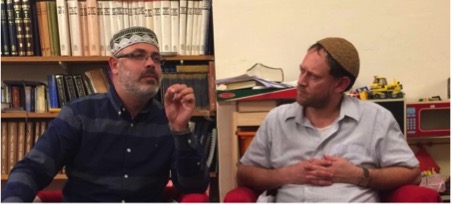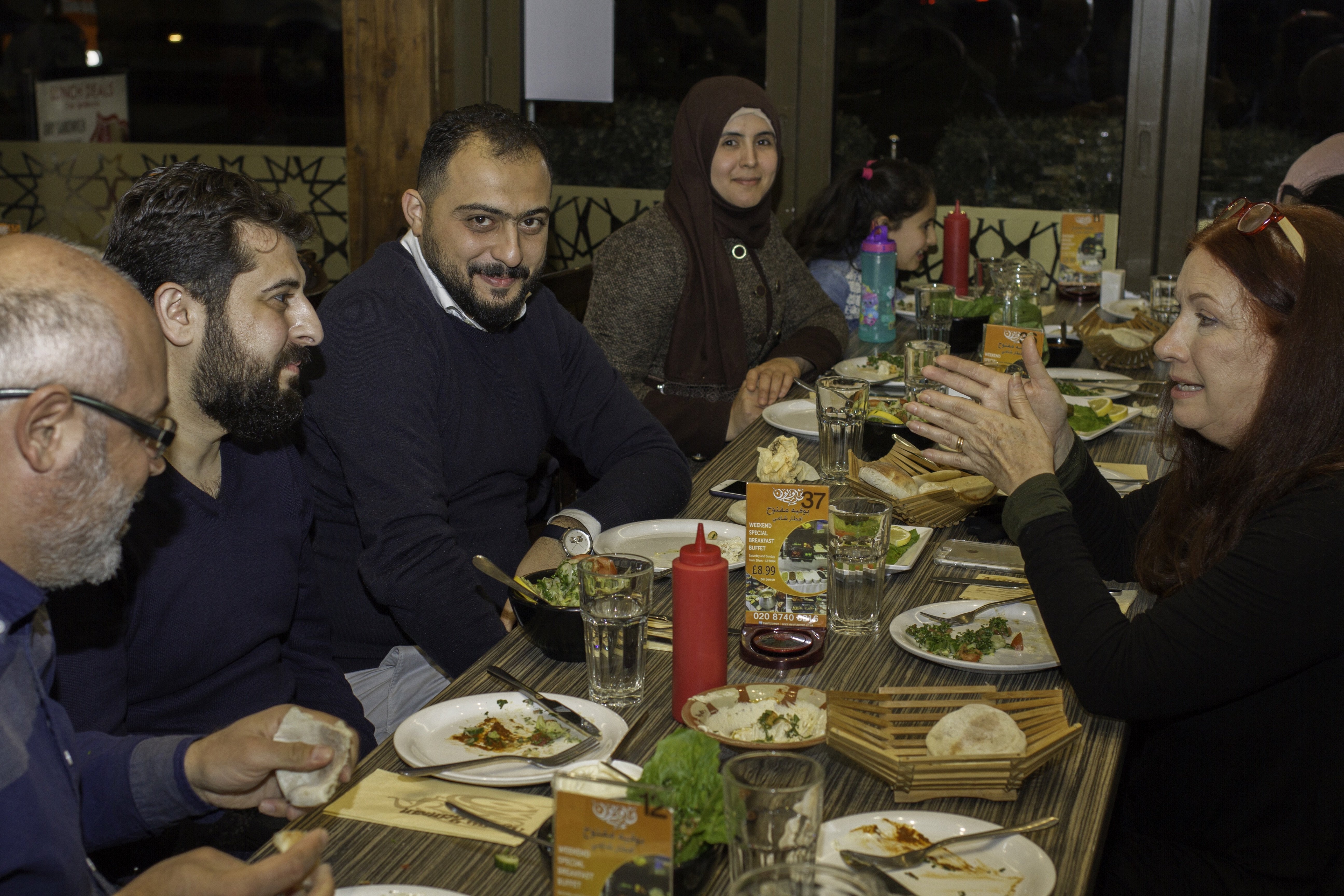
Dear Friends. This is a blog about celebrating Shavuot at Rabbi Wittenberg’s. ❤ Anna
At 12:30 AM Ghassan and I arrive at Rabbi Wittenberg’s home to participate in an all night text study group commemorating the Jewish holiday of Shavuot.
It is a holiday that has evolved and changed a lot over the centuries and for this reason it is a holiday that is celebrated in different ways by Jewish people in different parts of the world.
In ancient times Shavuot was a mid-summer harvest holiday celebrated locally by different tribes on communal threshing grounds where wheat was being separated from chaff.
Then sometime around the 7th or 8th century BCE, the Jerusalem monarchy and priesthood consolidated their power, and brought these separate local tribes together under their rule. As part of trying to consolidate their power they co-opted these local celebrations and replaced them with unified rites that could only be performed at the Temple in Jerusalem.
This not only brought together these separate tribes and gave them a sense of people-hood, it also was a way of enriching the temple.
The word Shavuot, which means “weeks”, comes 7 weeks and 1 day, (50 days) after the 2nd day of Passover.
Bread is an important part of both Passover and Shavuot. For Passover, unleavened bread (motzo) made from the first crop of barley is the main food, and for Shavuot, leavened bread made out of the first crop of wheat is the major food.
On Shavuot, traditionally, farmers would present two loaves of leavened bread to the temple priests while chanting Hebrew texts about loyalty to God, and the common history of the tribes.
The priests then “Waved” the loaves of bread “Before The Lord” together with wine, and a complicated array of animal sacrifices, (seven lambs, two rams and two goats) much like those sacrificed on Passover.
After the destruction of the Jewish Temple in Jerusalem by the Romans in 70 CE, Shavuot had to be adapted to the new realities that faced the Jewish People.
With no temple to make a pilgrimage to, and with no place make sacrifices in, Shavuot had to be reshaped under the guidance of the rabbis.
From the 2nd century on, Shavuot began to be associated with the appearance of God, and the presentation of the Torah, to Moses on Mount Sinai.
For various reasons as Shavuot continued to evolve through out the centuries, it also came to be associated with eating dairy products.
The custom of staying up all night to study texts on Shavuot, began in Thessaloniki Greece in 1533 when Joseph Caro, the famous authority on Jewish Religious law (Halaka), and his friend the Kabbalist, and poet, Shlomo Halevi Alkabetz, and their colleagues stayed up all night on Shavuot to study religious texts.
Many scholars believe this innovation was due to the influence of Islamic and Sufi practitioners who stayed up all night studying the Quran on the Night of Power (Lailat al Qadr) during the festival of Ramadan, to commemorate the giving of the Quran to Mohammed.
The practice of staying up all night studying Torah on Shavuot came to be known as Tikkun Leil Shavuot. (The concept of tikkun means repairing the world, and refers to performing acts that repair the world.)
There is also an interesting connection between the Jewish celebration of Shavuot and the Christian celebration of Pentecost.
The word “Pentecost comes from the Greek word “pentekostos”, which means 50. For Christians Pentecost comes 50 days after Easter, and it commemorates the descent of the Holy Spirit upon the followers of Jesus while they were gathered in Jerusalem for the celebration of Shavuot.
Just as Shavuot was evolving to commemorate God giving Moses the Torah, which imparted divine knowledge to his followers, Pentecost is celebrated to memorialize the imparting of divine knowledge to the followers of Jesus.
It is in this spirit that Rabbi Wittenberg has invited Ghassan and I to his home to join about 30 of his students and friends to study texts together for Shavuot.
Ghassan will be the guest scholar and together with Rabbi Wittenberg will be leading the Tikkun Leil Shavuot.
When we arrive a large buffet with many dairy dishes, bread, pastries, fruits, nuts and sweets is laid out in the kitchen.
After we have eaten, we assemble around a series of tables that extends through the dining room, parlor and living room. Texts are distributed and we begin to analyze their contents.
The first set of texts has to do with opening the eyes and seeing. These texts acknowledge the stages that the act of seeing goes through, and just as the texts describe, each of us around the table have the experience of first reading the text and thinking we understand it, then as we read it more carefully, the act of seeing these texts leads us to a deeper meaning and experience, and as we read the texts again and discuss them further another veil is lifted and we experience an even deeper meaning.
Rabbi Wittenberg describes how as a young student he was exposed to the story of King Lear, and how he became obsessed by Shakespeare’s description of Lear’s decent into madness after he was tricked by two of his daughters into giving them his kingdom. Jonathon admitted that even today, more than forty-five years later, he still reflects on these passages, which he has committed to memory, and how he continues to experience insight into their meaning.
Ghassan describes how the Sufis ascribe 3 stages to the act of seeing and taking in information. The first stage is the rational stage, and in this stage he says we absorb information with our rational mind.
Then there is a second stage, and in the second stage we absorb information with our feelings.
Then Ghassan describes the third stage, and he says in this third stage we absorb the experience as a taste.
Ghassan goes on to describe the Isra and Mi’raj of the prophet Mohammed and says in the first phase of Mohammed’s night journey he encounters the angel Jibreel (Gabriel) in Mecca, and Jibreel presents Mohammed with the winged steed, Buraq and invites him on the night journey. In this phase Mohammed experiences the encounter with Jibreel and Buraq with his rational mind, but as his journey progresses, and Mohammed flies on Buraq’s back to Jerusalem, and he begins his ascent into heaven, he enters into the feeling phase of his journey.
Then in the final phase of his journey after meeting the prophets in each level of heaven, Mohammed leaves Jibreel behind, and encounters God alone. It is in this encounter with God that Mohammed experiences the third stage of absorbing his experience, and Mohammed can only experience this encounter with God, as a taste.
On one of our breaks several participants approach Ghassan and I and express awe and joy at the discovery that Ghassan’s Sufi teachings can offer such deep and insightful interpretations of the Jewish teachings. They suggest that Ghassan and Rabbi Wittenberg offer a seminar together for their congregation in December when we return to England for our next Abrahamic Reunion tour.
Our text study session resumes and continues throughout the night. Each time someone shares a new insight offering a deeper interpretation of the teachings, the entire group experiences an inner exaltation.
Finally as the sun is rising, and as I call an Uber so we can go home and sleep, Rabbi Wittenberg hugs Ghassan and shares that although he has had the opportunity to participate in interfaith text study groups in the past, it is rare that he has been able to experience the depth that he has experienced with Ghassan tonight.

 Personal Transformation Seminar
Personal Transformation Seminar Dear Supporters of Peace Around the World,
Dear Supporters of Peace Around the World,
 The Ahmadiyya, whose motto is “Love for all. Hatred for none,” regard themselves as a moderate sect of Islam. Persecuted in their native homes of India and Pakistan, they have a large population in England and in the USA. Part of their belief is to understand other religions and to counteract extremism.
The Ahmadiyya, whose motto is “Love for all. Hatred for none,” regard themselves as a moderate sect of Islam. Persecuted in their native homes of India and Pakistan, they have a large population in England and in the USA. Part of their belief is to understand other religions and to counteract extremism.
